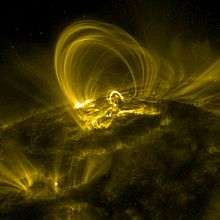TRACE
|
Illustration of TRACE | |||||
| Names | Explorer-73, SMEX-4 | ||||
|---|---|---|---|---|---|
| Mission type | Heliophysics | ||||
| Operator | NASA / GSFC | ||||
| COSPAR ID | 1998-020A | ||||
| SATCAT № | 25280 | ||||
| Website | trace.lmsal.com | ||||
| Mission duration |
Planned: 1 year Final: 12 years, 2 months and 19 days[1] | ||||
| Spacecraft properties | |||||
| Manufacturer |
NASA / GSFC Lockheed Martin[2] | ||||
| Launch mass | 250 kg (551 lb)[2] | ||||
| Dimensions | 1.9 × 1.1 m (6.2 × 3.6 ft)[2] | ||||
| Power | 220 W[3] | ||||
| Start of mission | |||||
| Launch date | April 2, 1998, 02:43:23 UTC[4] | ||||
| Rocket | Pegasus XL | ||||
| Launch site | Stargazer, Vandenberg AFB | ||||
| Contractor | Orbital Sciences | ||||
| Entered service | April 20, 1998[2] | ||||
| Orbital parameters | |||||
| Reference system | Geocentric | ||||
| Regime | Sun synchronous | ||||
| Semi-major axis | 6,914.2 km (4,296.3 mi) | ||||
| Eccentricity | 0.00267 | ||||
| Perigee | 517.6 km (321.6 mi) | ||||
| Apogee | 554.5 km (344.6 mi) | ||||
| Inclination | 97.5325° | ||||
| Period | 95.3667 min | ||||
| RAAN | 89.297° | ||||
| Argument of perigee | 91.5219° | ||||
| Mean anomaly | 32.1161° | ||||
| Mean motion | 15.1 rev/day | ||||
| Epoch | September 10, 2015, 19:19:29[5] | ||||
| Revolution number | 95290 | ||||
| Main telescope | |||||
| Name | TRACE Imaging Telescope | ||||
| Type | Cassegrain[2] | ||||
| Diameter | 30 cm (12 in)[2] | ||||
| Focal length | 8.66 m (28.4 ft)[2] | ||||
| Wavelengths | Ultraviolet and extreme ultraviolet[2] | ||||
| Resolution | 1 arcsec[2] | ||||

| |||||
Transition Region and Coronal Explorer (TRACE) was a NASA heliophysics and solar observatory designed to investigate the connections between fine-scale magnetic fields and the associated plasma structures on the Sun by providing high resolution images and observation of the solar photosphere, the transition region, and the corona. A main focus of the TRACE instrument is the fine structure of coronal loops low in the solar atmosphere. TRACE is the fourth spacecraft in the Small Explorer program, launched on April 2, 1998, and obtained its last science image in 2010.[6]
The satellite was built by NASA's Goddard Space Flight Center. Its telescope was constructed by a consortium led by Lockheed Martin's Advanced Technology Center. The optics were designed and built to a state-of-the-art surface finish by the Smithsonian Astrophysical Observatory (SAO). The telescope has a 30 cm (12 in) aperture and 1024×1024 CCD detector giving an 8.5 arc minute field of view. The telescope is designed to take correlated images in a range of wavelengths from visible light through the Lyman alpha line to far ultraviolet. The different wavelength passbands correspond to plasma emission temperatures from 4,000 to 4,000,000 K. The optics use a special multilayer technique to focus the difficult-to-reflect EUV light; the technique was first used for solar imaging in the late 1980s and 1990s, notably by the MSSTA and NIXT sounding rocket payloads.
Image gallery
 TRACE image of some typical million Kelvin loops
TRACE image of some typical million Kelvin loops Image of a sunspot taken by TRACE
Image of a sunspot taken by TRACE TRACE mosaic of the full-disk Sun
TRACE mosaic of the full-disk Sun
References
- ↑ "TRACE science mission terminated". Lockheed Martin Solar and Astrophysics Lab. June 21, 2010. Retrieved September 13, 2015.
- 1 2 3 4 5 6 7 8 9 Rumerman, Judy A. (2009). NASA Historical Data Book, Volume VII: NASA Launch Systems, Space Transportation/Human Spaceflight, and Space Science 1989-1998 (PDF). NASA History Series. NASA. pp. 812–813. ISBN 978-0-16-080501-1. SP-2009-4012.
- ↑ "TRACE". National Space Science Data Center. NASA. Retrieved September 13, 2015.
- ↑ "TRACE - Trajectory Details". National Space Science Data Center. NASA. Retrieved September 13, 2015.
- ↑ "TRACE - Orbit". Heavens Above. September 10, 2015. Retrieved September 10, 2015.
- ↑ "Transition Region and Coronal Explorer". Lockheed Martin Solar and Astrophysics Lab.
External links
![]() Media related to TRACE at Wikimedia Commons
Media related to TRACE at Wikimedia Commons
- TRACE website by Lockheed Martin
- TRACE Data Center by Lockheed Martin
- TRACE website (archived) by NASA's Goddard Space Flight Center
.png)

